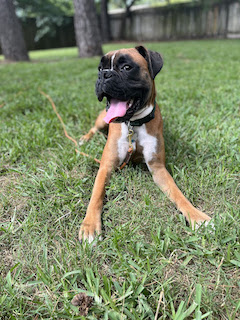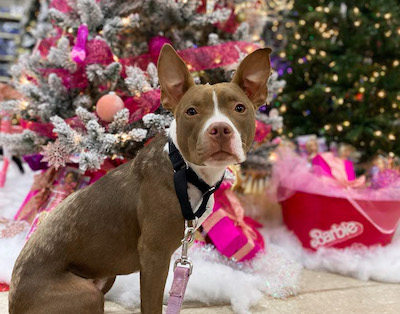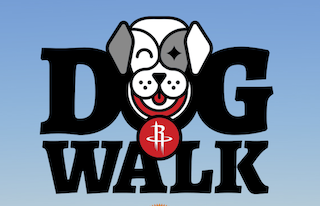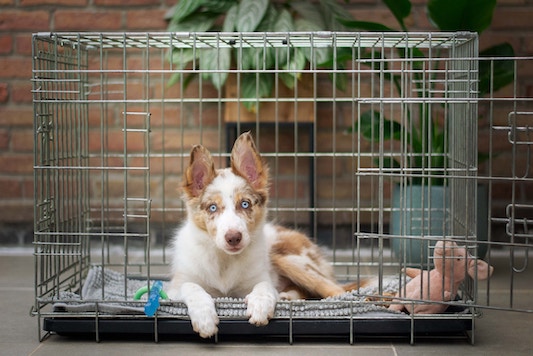Teaching your puppy how to down can be such a useful obedience tool, especially if you are someone who wants to incorporate them into your day to day activities. Down tends to be an easier long term position to maintain, so it’s great for those Sunday funday brunches. Or if you are someone who eventually wants to work on off leash recall, a distance down is an amazing safety command to be certain your pup will go into a down immediately on command in case anything potentially dangerous is around you. Down is a versatile and useful command, now we’ll break down how to begin teaching it.
To get started, you will need:
- A properly fitted collar
- A flat 6ft leash
- Kibble or treats
- Treat pouch
Check out our Puppy Supplies List blog for links to the supplies we recommend and more!

Teaching the position and luring
Down means place your belly completely flat to the ground. With a smaller breed or for general ease, start by sitting or kneeling. Create a little space, at least an arms length away.
Using a lure
- Keep the treat in one hand in between your thumb and pointer finger. Place the treat right up to your puppy’s nose and slowly lower your hand palm down towards the floor. Look at the ground as you lure them downwards.
- As soon as your puppy bows, bridge “good” and treat. If your puppy goes all the way into a down, go ahead and reward with a few pieces of treats and big praise.
- To release them, say “free” and toss a treat away. If your puppy doesn’t want to get up from the down position, you can coax them up with a little leash pressure or clapping. This is 1 repetition.
- After 1-3 repetitions, begin waiting for your puppy to lay all the way flat before saying “good” and treating. Continue to practice in the same spot.
Fading the lure
- After your puppy is quickly going into a down position, keep your puppy in the same rhythm, move treats to your opposite hand, and deliver a hand signal with the hand you first started with. We recommend a flat palm down to the ground.
- When you deliver the hand signal to the floor, as soon as your puppy lays down, bridge “good” and deliver a treat with the other hand. Then free. This is 1 repetition.
- If your puppy is ready, place the treats back in your treat pouch. Practice 3-5 repetitions of successful downs on a hand signal before moving on.
- If your puppy can achieve 3-5 in a row (if you are on the ground go ahead and stand up), and repeat 3-5 more hand signal commands, bridging and treating each time.
Teaching the verbal command
- To introduce the verbal command, maintain the same rhythm and say the verbal “down” first. Look at the ground while you are doing this to help direct them. If your puppy does not go into a down immediately deliver a hand signal right after. As soon as they down, bridge “good” and feed.
- Repeat this until your puppy is downing consistently. Faster repetitions work best here, as you’ll want to fade out your hand signal as quickly as possible.
- When your puppy downs on a verbal command alone, bridge and “feed” and immediately fade out the hand signal.
Teaching duration
Duration means how long can your puppy hold the down position. If you’ve read any of our other “How to” blogs, you may be familiar with our 5 main D’s. Duration, distance, distractions, direction, and disappearing. Let’s start with how to maintain your pups duration, and then we will talk about the others.
- When you say “Fido, Down” as soon as your puppy goes into a down position, bridge “good” and feed. Immediately after, say “stay.”
- Let’s start with a duration goal of 10 seconds. Continue to say “good” and feed every 2 seconds, until you hit 10 seconds, then you will say “free!.” Do not feed once they are released.
- Continue to increase the amount of time your puppy is maintaining a down stay. If they did well with the last trial, space out your treats to every 5 seconds for a total of 10 seconds. From there you can continue increasing your trial times in small increments. Next trial have your puppy hold down stay for 15 seconds, feeding every 5 seconds. Then 20 seconds, 30, 1 minute, etc.
- As they are reaching these goals, begin thinning out the amount of treats you are giving with each trial. Start easy! Start with a goal of 30 seconds, and work your way up to 1 minute, then 5, 10, etc.
- If at any point your puppy gets up from the down stay, restart the trial by re-prompting the down and continue to reinforce when they are successful.
We are now going to focus on adding in the other 4 D’s:
- Distance – How far you walk away OR how far you are from your puppy when you prompt them
- Distraction – Any type of sights, sounds, and stimuli around them
- Direction – Walking away from them in different directions or asking them from another area
- Disappearing – Going out of sight (one of the most difficult!)
You will want to practice adding these in one at a time. As your puppy is becoming more successful with holding their stay you can continue to add in more of the D’s or make the existing D’s more challenging. If you find your puppy is struggling, you may need to decrease one or more of the D’s.

Additional Troubleshooting:
We want you and your pup to be successful! If your puppy is struggling, we recommend potentially adjusting one or more of the following:
- Keep your puppy hungry before practicing
- Up the value (aka the tastiness) of your treats
- Reward more frequently
- Decrease the difficulty of one or more of your D’s
- Have fun with it! If you or your puppy are getting frustrated, take a break and play with them
- Keep your goals realistic. Start with less distraction when asking for down or work on a smaller time frame for them to hold down. Make sure they are achieving successful repetitions. That will lead to both a happy owner AND pup
- Always end on a successful rep!
We are excited for you to get a jumpstart on your journey to the down-stay. If you find you would like additional help with downs in front of higher distractions, increasing the amount of time they will stay down, or want them to learn about prompting down at a distance, our certified behavior consultants and trainers are here to help! Contact one of our Beyond the Dog Houston team members.




